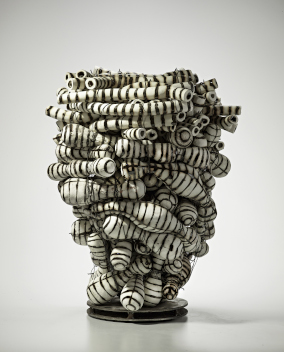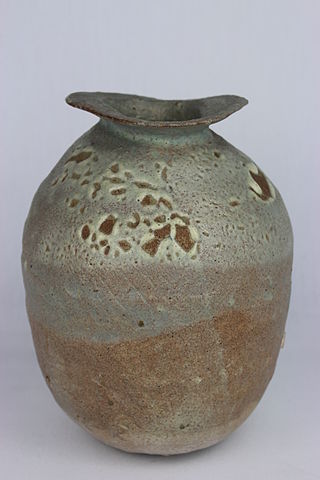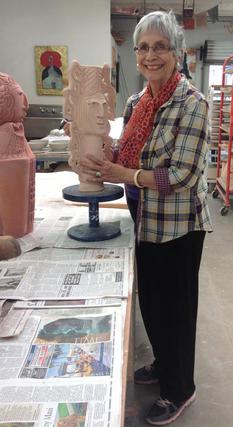Paul Edmund Soldner was an American ceramic artist and educator, noted for his experimentation with the 16th-century Japanese technique called raku, introducing new methods of firing and post firing, which became known as American Raku. He was the founder of the Anderson Ranch Arts Center in 1966.

Studio pottery is pottery made by professional and amateur artists or artisans working alone or in small groups, making unique items or short runs. Typically, all stages of manufacture are carried out by the artists themselves. Studio pottery includes functional wares such as tableware and cookware, and non-functional wares such as sculpture, with vases and bowls covering the middle ground, often being used only for display. Studio potters can be referred to as ceramic artists, ceramists, ceramicists or as an artist who uses clay as a medium.

Dame Lucie Rie, was an Austrian-born, independent, British studio potter working in a time when most ceramicists were male. She is known for her extensive technical knowledge, her meticulously detailed experimentation with glazes and with firing and her unusual decorative techniques.
Joan Takayama-Ogawa, is an American ceramic artist and educator. She is sansei (third-generation) Japanese-American, and a professor at Otis College of Art and Design in Los Angeles, California. Takayama-Ogawa's heritage since the 15th century of Japanese ceramic art influences her work, that usually explores beauty, decoration, ornamentation and narrative while also introducing a dialogue that rejects the traditional role of women in Japanese culture.

Julian Francis Stair is an English potter, academic and writer. He makes groups of work using a variety of materials, from fine glazed porcelain to coarse engineering brick clays. His work ranges in scale from hand-sized cups and teapots to monumental jars at over 6 feet tall and weighing half a ton.

Angus Suttie was a studio potter and teacher of art ceramics, most notably at Morley College, London. Suttie studied at Camberwell School of Art under Glennys Barton, Ewen Henderson and Colin Pearson. This education promoted experimentation, rejecting the Bernard Leach derived Anglo-oriental style which emphasised wheel-throwing. Having studied together at Camberwell, Angus was invited by Sara Radstone to share her studio space in South London; he and Radstone went on to exhibit together on several occasions, most notably in their two-person show at Contemporary Applied Arts in London's Covent Garden.
Adrian Saxe is an American ceramic artist who was born in Glendale, California in 1943. He lives and works in Los Angeles, California.

Annabeth Rosen is an American sculptor best known for abstract ceramic works, as well as drawings. She is considered part of a second generation of Bay Area ceramic artists after the California Clay Movement, who have challenged ceramic traditions involving expression, form and function and helped spur the medium's acceptance in mainstream contemporary sculpture. Rosen's sculptures range from monumental to tabletop-sized, and emerge out of an accumulative bricolage process combining dozens or hundreds of fabricated parts and clay fragments and discards. Reviewers characterize her art as deliberately raw, both muscular and unapologetic feminine, and highly abstract yet widely referential in its suggestions of humanoid, botanical, aquatic, artificial, even science-fictional qualities. Critic Kay Whitney wrote that her work is "visceral in its impact, violent even, but also sensual and evocative" and "floats between the poles of the comic and the mordant."

Elizabeth Fritsch CBE is a British studio potter and ceramic artist born into a Welsh family in Whitchurch on the Shropshire border. Her innovative hand built and painted pots are often influenced by ideas from music, painting, literature, landscape and architecture.

Rupert Deese was an American ceramic artist. He is known for innovative design and decoration of high fired ceramics. Deese wrote "It is my hope in making these vessels that as the perception of their beauty diminishes over time, they will sustain themselves by pleasant usefulness."

James Ewen Henderson was an English ceramic artist.

Ann Agee is an American visual artist whose practice centers on ceramic figurines, objects and installations, hand-painted wallpaper drawings, and sprawling exhibitions that merge installation art, domestic environment and showroom. Her art celebrates everyday objects and experiences, decorative and utilitarian arts, and the dignity of work and craftsmanship, engaging issues involving gender, labor and fine art with a subversive, feminist stance. Agee's work fits within a multi-decade shift in American art in which ceramics and considerations of craft and domestic life rose from relegation to second-class status to recognition as "serious" art. She first received critical attention in the influential and divisive "Bad Girls" exhibition, curated by Marcia Tucker at the New Museum in 1994, where she installed a functional, handmade ceramic bathroom, rendered in the classic blue-and-white style of Delftware. Art in America critic Lilly Wei describes Agee's later work as "the mischievous, wonderfully misbegotten offspring of sculpture, painting, objet d'art, and kitschy souvenir."
Madeleine Child is a New Zealand ceramicist and teacher. She was born in Sydney in 1959 and moved to New Zealand in 1968.

Dora De Larios was an American ceramist and sculptor working in Los Angeles. She was known for her work's clean lines and distinctive glazes, as well as for her line of tableware created under her family-run company Irving Place Studio. Also a muralist working with tile, De Larios was noted for her style, which reflects mythological and pan-cultural themes.
Garth Clark is an art critic, art historian, curator, gallerist, and art dealer from Pretoria, South Africa.
Chris Gustin is an American ceramicist. Gustin models his work on the human form, which is shown through the shape, color, and size of the pieces.

Nancy Selvin is an American sculptor, recognized for ceramic works and tableaux that explore the vessel form and balance an interplay of materials, minimal forms, and expressive processes. She emerged in the late 1960s among a "second generation" of Bay Area ceramic artists who followed the California Clay Movement and continued to challenge ceramic traditions involving expression, form and function, and an art-world that placed the medium outside its established hierarchy. Her work has been exhibited at the Los Angeles County Museum of Art (LACMA), Denver Art Museum, Daum Museum of Contemporary Art and Kohler Arts Center, and belongs to the public art collections of LACMA, the Smithsonian Institution, Oakland Museum of California, and Crocker Art Museum, among others. Critic David Roth has written, "Selvin's position in the top rank of ceramic artists has come through a process of rigorous self-examination … what differentiates [her] is that she eschews realism and functionality, indicating a level of intellectual engagement not always found among ceramicists." Writer and curator Jo Lauria described Selvin's tableaux as "elegiac and stylistically unified" works that serve as "forceful essays on the relationship between realism and abstraction, object and subject, decoration and use." Selvin lives and works in the Berkeley, California area.
Cynthia Bringle was born in Memphis, Tennessee, and has lived and worked in Penland, North Carolina since 1970. She is a potter and teaches at the Penland School of Crafts, Anderson Ranch Arts Center, and John C. Campbell Folk School.

Jennifer Elizabeth Lee is a Scottish ceramic artist with an international reputation. Lee's distinctive pots are hand built using traditional pinch and coil methods. She has developed a method of colouring the pots by mixing metallic oxides into the clay before making. Her work is held in over forty museums and public collections worldwide, including the Metropolitan Museum of Art in New York, the Philadelphia Museum of Art, the Los Angeles County Museum and the Victoria and Albert Museum. In 2018 Lee won the Loewe Craft Prize, an award initiated by Jonathan Anderson in 2017. The prize was presented to her at an awards ceremony at The Design Museum in London.













